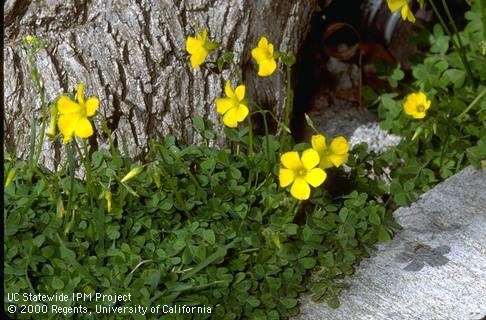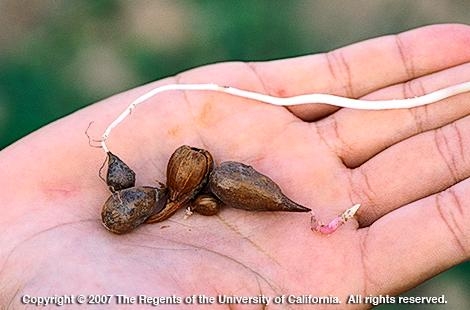Garden Advice from the Help Desk of the
UC Master Gardener Program of Contra Costa
(minor correction October 31, 2016)
Client's Request: How can I get rid of oxalis in my yard? I pull it out and think I've got it all, but it just comes back with more gusto the following year. It's annoying, to say the least!

Homeowners and gardeners wishing to eradicate Bermuda buttercup face a tenacious, prolific weed which has devised many successful survival strategies. Each year, after the first seasonal rains, and sometimes before in a dry year, about a dozen ovoid bulbils develop along the length of the threadlike, underground rhizome. These readily detach from the rhizome to replenish the soil seed bank.
Another survival technique of Bermuda buttercup is that, after initial removal by hand, new plants will grow from broken off stem segments left in the soil. Several passes at hand weeding may be necessary to completely remove this new growth. Discouraging survival of Bermuda buttercup can usually be accomplished by gently pulling on the plant and removing all of it just as it is about to flower. By this time, the parent bulb energy reserves are exhausted. The parent bulb should be completely dried out and most young bulbils are too immature to survive disturbance.

Though prevention is the best control method, soil solarization can reduce the bulb population. To be effective, solarization using a clear plastic tarp treated with an ultraviolet light inhibitor must be in place for no less than 4 consecutive weeks during June, July, or August. The sun's rays will heat up the soil to temperatures that are lethal to Bermuda buttercup bulbs (and most everything else in the top several inches). Some researchers investigating approaches for controlling Bermuda buttercup also suggest covering it with stiff cardboard and applying a thick layer of mulch. The goal is to weaken the bulbs and deprive the plant of sunlight, causing an inability to photosynthesize and eventual death by starvation. Chemical control can affect the top growth but is ineffective in preventing bulb germination.
The lack of movement of water and air between compacted clay soil molecules promotes the survival of Bermuda buttercup bulbils. Adding nitrogenrich organic matter will loosen existing soil particles and benefit soil structure by increasing porosity and improving drainage.
While complete eradication is practically impossible to achieve, following strict noncontamination practices, mulching, solarizing, improving soil structure and drainage are all steps gardeners can take to create an environment unfavorable to the establishment and survival of Bermuda buttercup.
For further information on managing this pest, visit www.ipm.ucdavis.edu and download UC's free Pest Notes publication 7444 entitled “Creeping Woodsorrel and Bermuda Buttercup.” (http://www.ipm.ucdavis.edu/PMG/PESTNOTES/pn7444.html)
UC Master Gardener Program of Contra Costa's Help Desk (CG)
*****************
This is an updated article authored by Chantal Guillemin, UC Master Gardener, and originally published in the March 19, 2011, Contra Costa Times. The HOrT COCO blog editor takes all responsibility for the above updated version.
A minor error was corrected Oct 31, 2016 to reflect, per the Pest Note above that woodsorrel can be a pest in nursery container-grown plants, while Bermuda buttercup isn't. See the Pest Note referenced abov for the specifics..
*****************
Come to the UC MGCC Program's Great Tomato Plant Sale
Walnut Creek 4/2&9, Richmond 4/9, and Antioch 4/16
Click for locations and plant lists!
Dozens of heirloom tomatoes & vegetables chosen especially for Contra Costa
Note: The UC Master Gardeners Program of Contra Costa's Help Desk is available year-round to answer your gardening questions. Except for a few holidays, we're open every week, Monday through Thursday for walk-ins from 9:00 am to Noon at 75 Santa Barbara Road, 2d Floor, Pleasant Hill, CA 94523. We can also be reached via telephone: (925) 646-6586, email: ccmg@ucanr.edu, or on the web at http://ccmg.ucanr.edu/Ask_Us/ MGCC Blogs can be found at http://ccmg.ucanr.edu/HortCoCo/ You can also subscribe to the Blog (//ucanr.edu/blogs/CCMGBlog/).